Optical fiber offered a new level of communication support at high speed and with an optimized technical base. But in order to achieve the maximum positive factors of the application of this technology, high-quality installation is required. The fact is that fiber optic cable only superficially resembles familiar and traditional means of signal transmission, but its structure is much more complex and demanding to handle.
What is fiber?
In itself, an optical fiber is a thin quartz tube-cylinder of varying degrees of density. Its composition is also heterogeneous, since alloying inclusions can be added to increase individual parameters even at the production stage. The functional structure is formed by two parts - the core and the sheath (does not apply to the insulating coating).
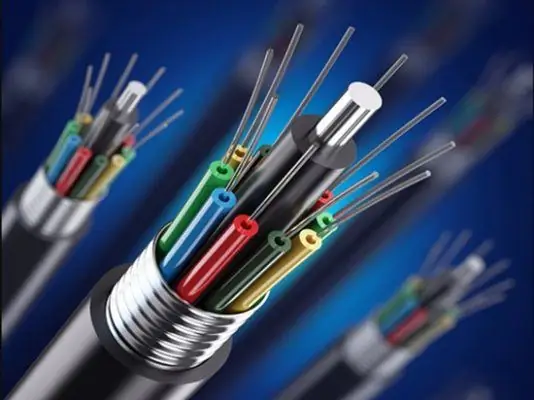
The light pulse is always within the boundaries of these two levels, but is reflected only to the core of the conductor. Actually, this principle of operation determines the high speed of data transmission by fiber optic cable. Twisted pair, by the way, in standard formats such as CAT3 and CAT5 provides a transmission rate of 10, 100, Mbps, while fiber reaches 1000 Mbps.
Classification by cable structure
An optical fiber line may contain one or more modes, which are understood as the mode of propagation of a light beam. Single-mode cables ensure that all beams are transmitted in one direction. They travel the same path at the same speed, reaching their end point at the same time without distorting the signal. Technologically, the operation of single-mode fiber optic cable is supported by laser receivers, which use light radiation with only one wavelength.
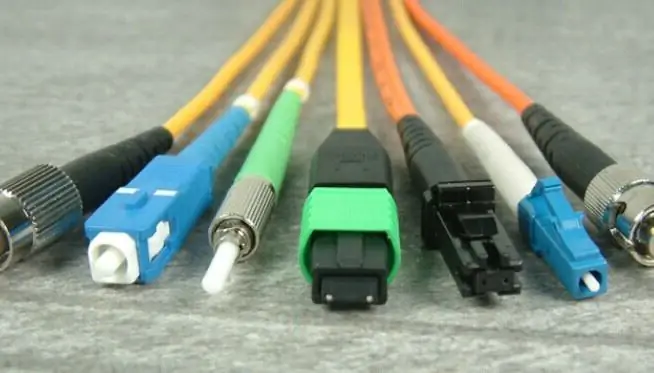
Multi-mode fibers support multiple light paths, which causes a significant spread of rays, so the signal is distorted. Direct transmission is provided not by a laser, but by a standard LED, which reduces the cost of laying the line. The same decision affects the increase in the service life of the cable relative to the performance of a single-mode conductor.
Cable classification by purpose
Perhaps one of the weaknesses in terms of laying fiber optic cable will be its low versatility. The sensitive structure often imposesrestrictions on the use of one cable in different conditions. Typically, this is due to the thickness and protective insulators of the wire. Therefore, at the basic level, the following types of fiber are distinguished:
- For outer lining. Usually forms backbone networks for many kilometers. Makes high demands on external protection - mainly from mechanical damage, therefore, armored insulation based on steel, aluminum or polycarbonate has become widespread. A metal wire is also used in the wire structure to stiffen the contour.
- For inner lining. A typical representative of this group is a fiber optic cable for the Internet, which can form a multi-level and complex network for transmitting information to a wide array of subscribers within a small subsystem. If we are talking about internal trunk lines, then fiber can be used in combination with twisted pair.
- For cords. Optical or switching cable segments that perform not so much the functions of a signal conductor, but the tasks of transitional connections over short distances.
Cable specifications
Like other types of conductors, optical fiber has a wide range of different parameters. If we talk about the most common formats and the average standard, then the electrical characteristics of a fiber optic cable can be represented as follows:
- Resistance of metal insulation in contact with ground/water at 1 km - not less than 2000 MΩ.
- Ability to endurevoltage in a circuit with metal insulation - up to 20 kV.
- Maximum allowable surge current up to 105 kA.
- Bending radius - up to 20 external cable diameters.
- The service life of optical cables is up to 25 years.
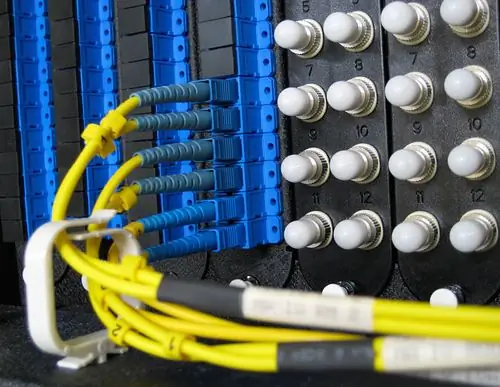
In terms of core sizes, the diameter range for single-mode fiber is 8-10 µm, and for multi-mode cores, it ranges from 50 to 62.5 µm. At the outer sheath, the standard diameter is universal for all types of optical fiber and is 125 microns. Such cables can be used in a structured cabling system with detachable and non-detachable connections. For specialized applications under special conditions, an insulating sheath buffer can be used, with which the outer diameter will vary from 250 to 900 microns.
Technological steps for laying fiber optics
After agreeing on the necessary documents, you can begin to develop a technical solution. At the first stage, the optimal way of organizing the cable line is selected. If we are talking about the main route, then almost all laying options are allowed - underground, under water, by air or by land. To a large extent, this will depend on the type of the conductor itself. For example, a self-supporting fiber optic cable based on high-strength aramid yarns is optimally suited for suspension on power transmission and communication support lines. Moreover, it is used both for the device of small circuits between houses, and for kilometer routes. In any case, the selected cable is subjected to carefulcontrol and only after that it is allowed for installation.

At the next stage, the track itself is being prepared. The main tasks of the performers in this part are to provide the most favorable conditions for laying, fixing and future operation of the cable. The support-bearing infrastructure must be provided, and the laying line itself is formed with the expectation of minimizing bends and turning points. Then you can proceed directly to work activities.
Closed underground laying
Location of the fiber optic line underground can be carried out in an open trench way or through a pipeline. Insulating pipes for stretching cables in them are usually used when laying thick routes over many kilometers. The most reliable way is to organize a trench 70-150 cm deep, and then mount support posts or blocks. A pipe is laid on them, into which the line is preliminarily wound. As a rule, the laying of fiber optic cable underground is carried out in segments. The protective pipes alternately form a contour and are welded in parts, and the line is drawn as the distance increases. At the final stage, the track is covered with earth.
Open underground cable routing
In this case, they do without special pipes, but with the use of a cable layer. This is a device that allows you to place the fiber in the trench with minimal bends and maintaining the intended fixation contour. During the laying process, the cable is smoothly passed through the cable laying knife cassette with a previouslyset bending range. It is important that the laying depth is at least 120 cm and that there are no frequent intersections with underground utilities on the way.
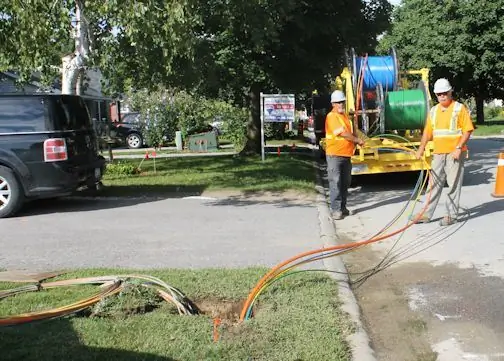
In order for the fiber optic cable to be placed along the entire route with the same parameters of the permissible slope angle, the bending radius in the stacker must remain the same throughout the entire distance. After the laying is completed, a signal tape is laid above the level of the cable, and electronic marker informants are installed at the points of intersection with other communications.
Air Suspension
To install the cable in this way, you can use the existing infrastructure of power lines, rail or urban transport, depending on the characteristics and purpose of the route. As already noted, the simplest over-the-air installation of fiber optic cable is carried out using a self-supporting wire. In this case, a bundle of cables is laid in one direction. Fastening is made to a pre-stretched cable. As the rigid wire unwinds, the optical fiber is glued to it and tied with polyethylene thread. Ties and clamps can only be used as an addition to the fixing system. The small mass of optical fiber allows its cables to be laid under tension for many kilometers.
Methods of connecting optical fibers
It is desirable to avoid frequent connection nodes, but it will not be possible to completely eliminate them anyway. Regardless of the method of laying and purpose of the cableyou will need to flatten the two contours.
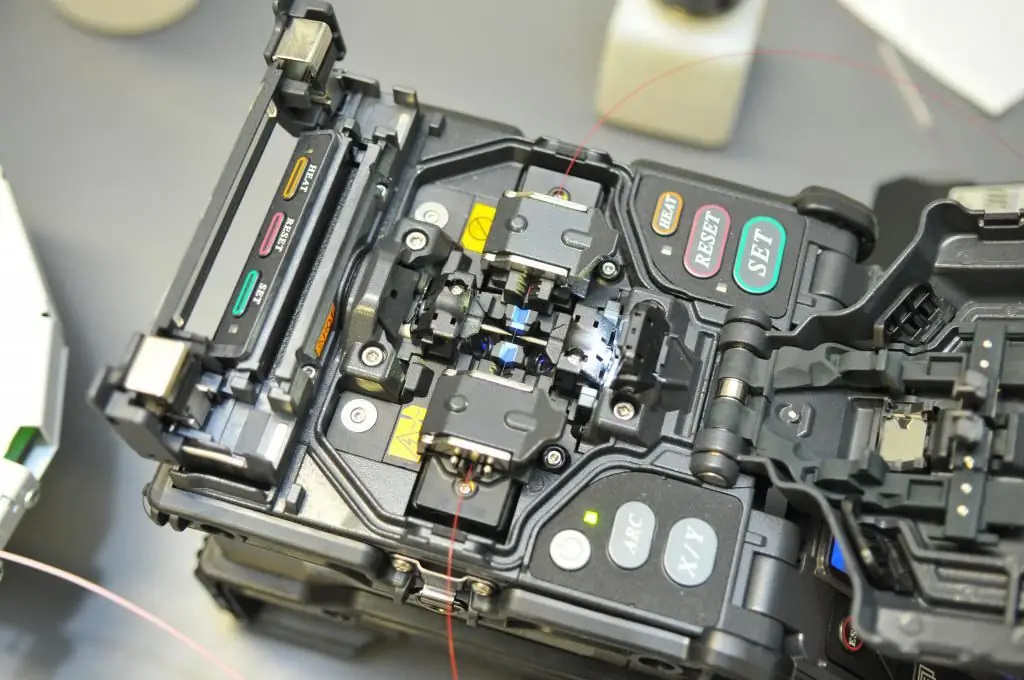
This is done in the following ways:
- With connectors. A design option that involves the use of mechanical devices - a kind of splitters. The method is convenient, but the quality of communication and the reliability of such a connection leave much to be desired.
- Glue. A more reliable option for connecting a fiber optic cable, performed using epoxy glue. It is desirable to use two-component compositions with a refractive characteristic corresponding to a particular fiber. This method gives a good operational effect, but the installation process itself can cause a lot of trouble.
- Welding. A special soldering iron is used to heat-treat the ends of two fiber lines, after which the pliable structure forms a monolithic joint. The seam is reinforced with heat-shrinkable sleeves and after a while allows the cable to be used in further installation operations.
Fiber optic connection
When the line is brought to the direct object of operation, it remains only to complete the installation process with the help of electrical fittings. The socket will be the basic element in this infrastructure. It is located in a house or apartment at the entrance and connects the consumer's equipment to the switchboard.
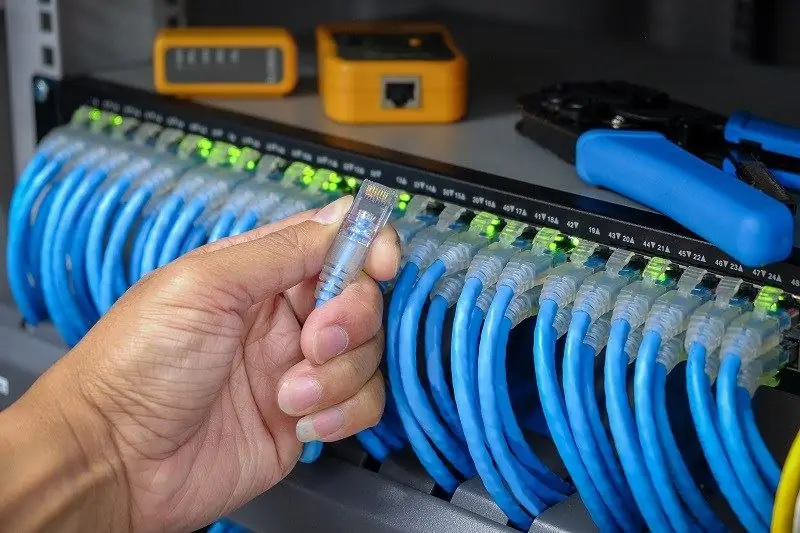
To enter the cable into the socket, it is desirable to use an optical patch cord. From this node, you can layfiber optic cable for the Internet under a router, a line for a phone or a TV. Crimping crimpers for standard RJ11 connector, RJ format plug, as well as cable stripping tools are used during installation operations.
Conclusion
It is difficult to overestimate the importance of optical fiber for the organization of modern telecommunication lines. Practicality and versatility, coupled with high technical and operational data, have made the fiber optic cable the most popular conductor of information both in commercial structures and at the household level. Of course, the negative factors of using this cable are not yet complete, which is expressed both in high cost and in individual installation nuances. But practice shows that these weaknesses are more than offset by the positive effects of the application, not to mention the desire of manufacturers to optimize the technology for laying fiber optic routes.






